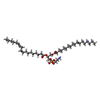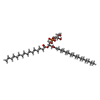+Search query
-Structure paper
| Title | Structural basis of α-scorpion toxin action on Na channels. |
|---|---|
| Journal, issue, pages | Science, Vol. 363, Issue 6433, Year 2019 |
| Publish date | Mar 22, 2019 |
 Authors Authors | Thomas Clairfeuille / Alexander Cloake / Daniel T Infield / José P Llongueras / Christopher P Arthur / Zhong Rong Li / Yuwen Jian / Marie-France Martin-Eauclaire / Pierre E Bougis / Claudio Ciferri / Christopher A Ahern / Frank Bosmans / David H Hackos / Alexis Rohou / Jian Payandeh /     |
| PubMed Abstract | Fast inactivation of voltage-gated sodium (Na) channels is essential for electrical signaling, but its mechanism remains poorly understood. Here we determined the structures of a eukaryotic Na ...Fast inactivation of voltage-gated sodium (Na) channels is essential for electrical signaling, but its mechanism remains poorly understood. Here we determined the structures of a eukaryotic Na channel alone and in complex with a lethal α-scorpion toxin, AaH2, by electron microscopy, both at 3.5-angstrom resolution. AaH2 wedges into voltage-sensing domain IV (VSD4) to impede fast activation by trapping a deactivated state in which gating charge interactions bridge to the acidic intracellular carboxyl-terminal domain. In the absence of AaH2, the S4 helix of VSD4 undergoes a ~13-angstrom translation to unlatch the intracellular fast-inactivation gating machinery. Highlighting the polypharmacology of α-scorpion toxins, AaH2 also targets an unanticipated receptor site on VSD1 and a pore glycan adjacent to VSD4. Overall, this work provides key insights into fast inactivation, electromechanical coupling, and pathogenic mutations in Na channels. |
 External links External links |  Science / Science /  PubMed:30733386 PubMed:30733386 |
| Methods | EM (single particle) |
| Resolution | 3.4 - 3.5 Å |
| Structure data | |
| Chemicals |  ChemComp-NAG:  ChemComp-Y01:  ChemComp-76F:  ChemComp-LHG:  ChemComp-AJP: |
| Source |
|
 Keywords Keywords | MEMBRANE PROTEIN / Sodium channel / scorpion toxin / electrical signaling / fast inactivation |
 Movie
Movie Controller
Controller Structure viewers
Structure viewers About Yorodumi Papers
About Yorodumi Papers







 periplaneta americana (American cockroach)
periplaneta americana (American cockroach) homo sapiens (human)
homo sapiens (human)